Social media analytics tools are software platforms designed to collect, analyze, and interpret data from social media channels. These tools help businesses and individuals gain valuable insights into their social media performance, audience behavior, and content engagement. By leveraging social media analytics, users can make data-driven decisions to optimize their social media strategies and achieve better results.
Social media analytics tools gather data from various social networks, such as Facebook, Twitter, Instagram, LinkedIn, and others. They track metrics like follower growth, post reach, engagement rates, click-through rates, and audience demographics. These tools provide comprehensive reports and visualizations, allowing users to understand their social media performance at a glance.
Some popular social media analytics tools include Hootsuite Analytics, Sprout Social, Buffer Analytics, and Keyhole. These platforms offer features like real-time monitoring, sentiment analysis, competitor analysis, and influencer tracking. By utilizing these tools, businesses can measure the success of their social media campaigns, identify top-performing content, and gain insights into their target audience’s preferences and behaviors.
Table of Contents
Key Metrics and Data Tracked
Social media analytics tools provide a wealth of data and metrics to help businesses and marketers understand the performance and impact of their social media efforts. Some of the key metrics and data points tracked by these tools include:
Engagement: This includes metrics such as likes, comments, shares, and clicks, which measure how users interact with and respond to your social media content. High engagement rates indicate that your content resonates with your audience and encourages active participation.
Reach: Reach refers to the number of unique users who have seen your content. It helps you understand the visibility and potential impact of your social media posts, allowing you to gauge the size of your audience and identify opportunities for growth.
Impressions: Impressions track the total number of times your content has been displayed, regardless of whether it was clicked or engaged with. This metric provides insights into the overall exposure of your social media presence and can be useful for measuring brand awareness and visibility.
Sentiment Analysis: Many analytics tools offer sentiment analysis capabilities, which use natural language processing to determine the overall sentiment (positive, negative, or neutral) expressed in social media conversations around your brand, products, or campaigns. This data can help you understand how your audience perceives your brand and identify potential issues or areas for improvement.
Audience Demographics: Social media analytics tools often provide detailed demographic information about your followers and engaged audience, such as age, gender, location, interests, and behaviors. This data can be invaluable for tailoring your content and messaging to better resonate with your target audience.
Conversion Tracking: For businesses with e-commerce or lead generation goals, analytics tools can track conversions from social media channels, such as website visits, email signups, or sales. This data helps you understand the direct impact of your social media efforts on your business objectives.
Competitor Analysis: Many tools offer competitive benchmarking features, allowing you to compare your social media performance against competitors or industry averages. This can provide valuable insights into areas where you excel or fall behind, helping you adjust your strategies accordingly.
By analyzing these metrics and data points, businesses can gain a comprehensive understanding of their social media performance, identify areas for improvement, and make data-driven decisions to optimize their social media strategies and achieve better results.
Benefits of Using Social Media Analytics Tools
Social media analytics tools offer a wealth of advantages for businesses and individuals looking to effectively leverage social media platforms. By providing in-depth insights into audience behavior, engagement metrics, and content performance, these tools empower users to make data-driven decisions and optimize their social media strategies.
One of the primary benefits is gaining a comprehensive understanding of your audience. Analytics tools reveal valuable demographic data, such as age, gender, location, and interests, allowing you to tailor your content and messaging to resonate with your target audience more effectively. Additionally, you can identify your most engaged followers and potential influencers, enabling targeted outreach and collaboration opportunities.
Measuring campaign performance is another crucial advantage. Analytics tools provide detailed metrics on impressions, reach, clicks, and conversions, enabling you to track the success of your social media campaigns and adjust tactics accordingly. This data-driven approach ensures that your efforts are yielding tangible results and maximizing return on investment.
Furthermore, social media analytics tools help identify emerging trends and popular topics within your industry or niche. By analyzing hashtag usage, mentions, and sentiment analysis, you can stay ahead of the curve and create timely, relevant content that resonates with your audience. This proactive approach can boost engagement, increase brand visibility, and establish thought leadership.
Content strategy optimization is another key benefit. Analytics tools provide insights into the types of content that resonate best with your audience, including preferred formats (videos, images, text), optimal posting times, and engagement drivers. Armed with this knowledge, you can refine your content strategy, maximize reach and engagement, and ensure your efforts are aligned with your audience’s preferences.
Overall, social media analytics tools offer invaluable insights and data-driven decision-making capabilities, enabling businesses and individuals to effectively navigate the ever-evolving social media landscape, connect with their audience, and achieve their marketing and communication objectives.
Popular Social Media Analytics Tools
Social media analytics tools come in various shapes and sizes, catering to different business needs and budgets. Here are some of the most popular options:
Hootsuite Analytics is a comprehensive platform that provides detailed insights into your social media performance across multiple networks. It offers real-time monitoring, customizable reports, team collaboration features, and integrations with various third-party apps.
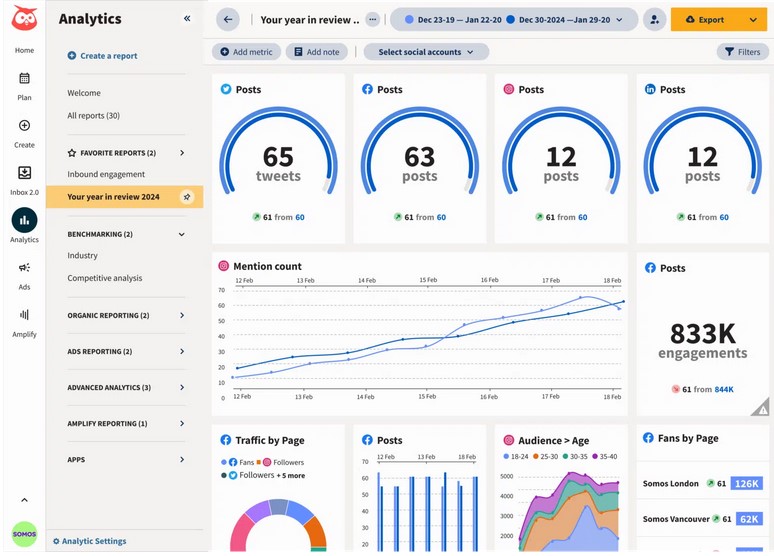
Sprout Social is a user-friendly tool that simplifies social media management and analytics. It provides in-depth data on engagement, audience demographics, and sentiment analysis. Additionally, it offers competitive analysis and social listening capabilities.
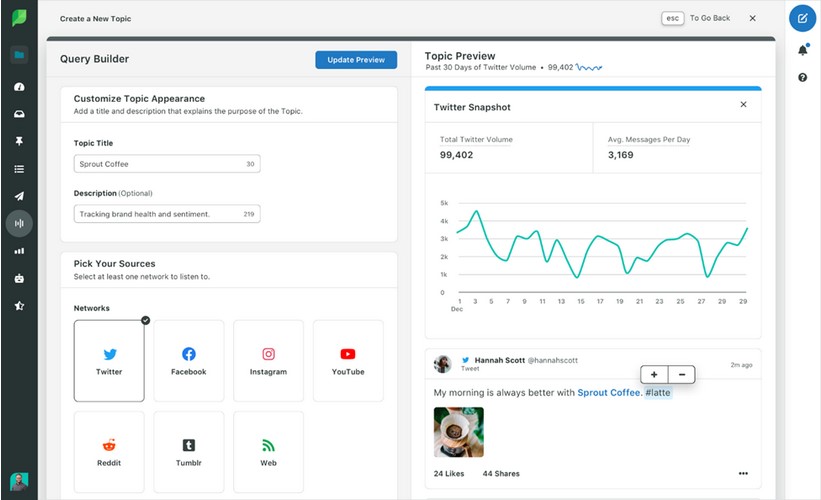
Buffer Analytics is a straightforward analytics solution that focuses on delivering clear and actionable insights. It provides data on engagement, reach, and audience growth, as well as tools for scheduling and publishing content across multiple platforms.
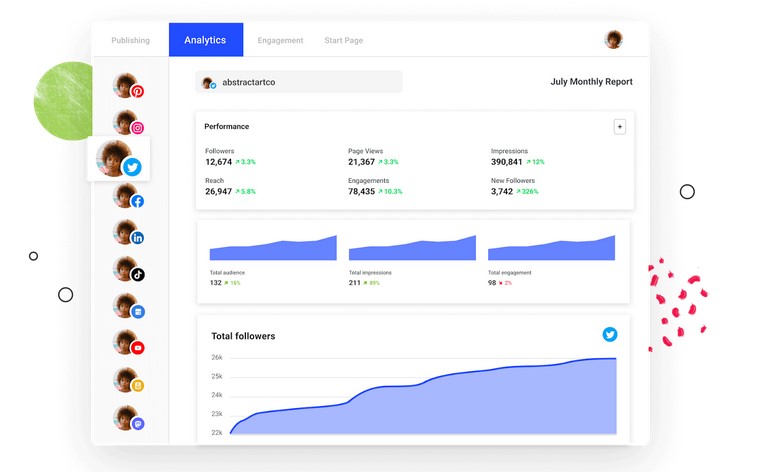
Quintly is a powerful analytics platform designed for agencies and enterprises. It offers advanced reporting features, benchmarking capabilities, and customizable dashboards. Quintly also supports cross-channel analysis and team collaboration.
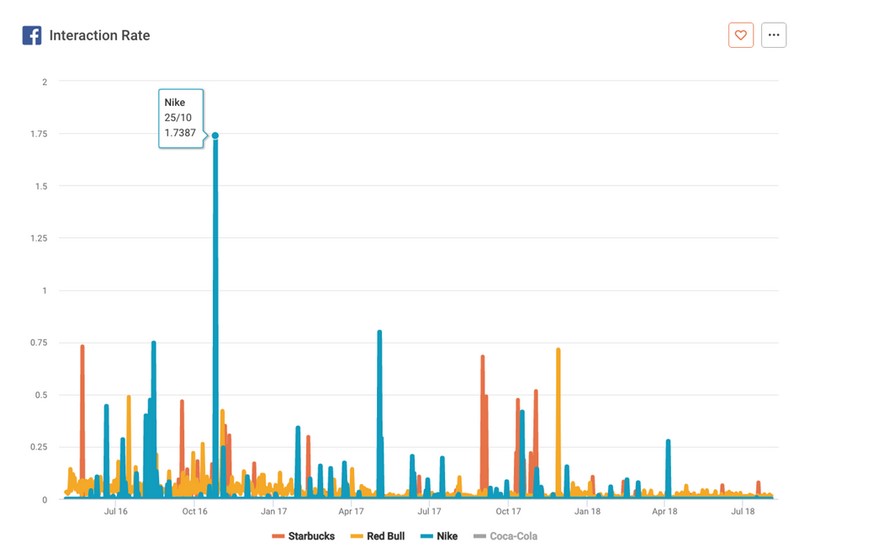
Keyhole is a social media analytics tool that specializes in real-time tracking and influencer marketing. It provides insights into hashtag performance, sentiment analysis, and audience demographics. Keyhole also offers campaign monitoring and competitor analysis features.
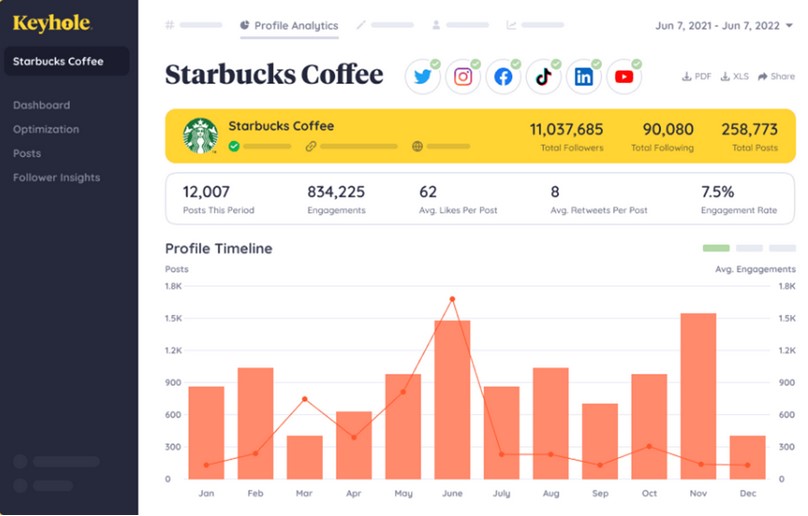
Many of these tools offer free trials or freemium pricing models, allowing businesses to test their features before committing to a paid plan. Paid plans typically range from affordable options for small businesses to enterprise-level solutions with advanced capabilities and custom pricing.
Choosing the Right Tool
Selecting the most suitable social media analytics tool is crucial for maximizing its effectiveness and ensuring a good return on investment. Here are some key factors to consider when choosing the right tool:
Business Size and Industry: Evaluate the size of your business and the industry you operate in. Larger enterprises with complex social media operations may require more robust and feature-rich tools, while smaller businesses or startups might benefit from more affordable, streamlined solutions.
Specific Needs and Goals: Clearly define your objectives for using a social media analytics tool. Are you primarily focused on monitoring brand mentions, measuring campaign performance, identifying influencers, or gaining insights into customer sentiment? Different tools excel at different aspects, so prioritize the features that align with your specific needs.
Supported Social Networks: Ensure that the tool you choose supports the social media platforms where your target audience is most active. While some tools cover a wide range of networks, others may specialize in specific platforms like Facebook, Twitter, Instagram, or LinkedIn.
Integrations and Compatibility: Consider the tool’s ability to integrate with other software and platforms you currently use, such as customer relationship management (CRM) systems, marketing automation tools, or content management systems (CMS). Seamless integration can streamline workflows and provide a more comprehensive view of your social media efforts.
Ease of Use and Learning Curve: Evaluate the tool’s user interface and overall usability. While advanced tools may offer more features, they can also have a steeper learning curve. Consider the skill level of your team and whether the tool provides adequate training and support resources.
Reporting and Visualization: Examine the tool’s reporting and data visualization capabilities. Clear, visually appealing reports and dashboards can help you quickly identify trends, patterns, and insights, making it easier to communicate findings to stakeholders.
Scalability and Customization: As your social media presence grows, ensure that the tool you choose can scale with your needs. Additionally, consider the level of customization options available, such as the ability to create custom reports or tailor the tool to your specific processes.
Budget and Pricing Model: Social media analytics tools can vary significantly in pricing, from free or freemium plans to enterprise-level solutions. Evaluate the tool’s pricing model (monthly/annual subscriptions, pay-per-use, etc.) and ensure it aligns with your budget and provides good value for the features offered.
Remember, there is no one-size-fits-all solution. Carefully assess your specific requirements, and don’t hesitate to request demos or trial periods to test the tools before making a final decision.
Integrating Analytics with Social Media Management
Integrating social media analytics tools with your overall social media management platform and strategies is crucial for maximizing the insights and value gained from these powerful tools. By seamlessly combining analytics data with your social media management processes, you can streamline workflows, make data-driven decisions, and achieve a comprehensive understanding of your social media performance.
Social media analytics tools provide invaluable data on audience demographics, engagement metrics, content performance, and more. However, this data becomes even more powerful when integrated with your social media management platform, allowing you to analyze and act upon the insights within the same ecosystem.
Integration enables you to easily track and measure the success of your social media campaigns, identify top-performing content, and make informed decisions about future content creation and promotion strategies. It also facilitates real-time monitoring and response to audience interactions, allowing you to quickly address concerns, capitalize on viral trends, and foster stronger relationships with your followers.
Moreover, by combining analytics with your social media management workflows, you can streamline processes such as content scheduling, team collaboration, and reporting. This integration eliminates the need for manual data entry and reduces the risk of errors, saving valuable time and resources.
Ultimately, integrating social media analytics with your management platform and strategies provides a holistic view of your social media presence, enabling you to make data-driven decisions, optimize your efforts, and achieve better results across all your social media channels.
Data Privacy and Security Considerations
When using social media analytics tools, it’s crucial to consider data privacy and security concerns. These tools collect and analyze vast amounts of user data, including personal information, online behavior, and social interactions. Failure to properly handle and protect this data can lead to serious consequences, such as data breaches, identity theft, and violations of privacy laws.
To mitigate these risks, social media analytics providers should implement robust security measures, such as encryption, access controls, and regular security audits. They should also have clear and transparent data privacy policies, outlining how user data is collected, used, and shared.
As a user of these tools, it’s important to understand the privacy implications and take steps to protect your own data and that of your audience. Always read and understand the privacy policies of the tools you use, and be mindful of the data you’re sharing and collecting.
Best practices for protecting user data include:
- Minimizing data collection: Only collect the data you truly need, and avoid unnecessary or excessive data gathering.
- Obtaining consent: Ensure you have proper consent from users before collecting and using their data, especially for sensitive or personal information.
- Anonymizing data: Whenever possible, anonymize or pseudonymize user data to protect individual privacy.
- Implementing access controls: Restrict access to user data to only those who truly need it, and implement strong authentication and authorization measures.
- Regular security audits: Regularly assess the security of your systems and processes, and promptly address any vulnerabilities or weaknesses.
- Compliance with regulations: Ensure your data practices comply with relevant privacy laws and regulations, such as the General Data Protection Regulation (GDPR) or the California Consumer Privacy Act (CCPA).
- Transparency and communication: Be transparent about your data practices, and communicate clearly with users about how their data is being used and protected.
By prioritizing data privacy and security, social media analytics providers and users can build trust with their audiences and avoid potential legal and reputational risks.
Real-world Use Cases and Success Stories
Social media analytics tools have proven invaluable for businesses and individuals across various industries. Here are some real-world examples of how these tools have been effectively utilized:
Increasing Brand Awareness and Engagement
A popular fashion brand used social media analytics to identify influencers and brand advocates within their target audience. By analyzing engagement metrics and sentiment analysis, they were able to collaborate with these influential individuals, leading to a significant increase in brand awareness and engagement on social platforms.
Optimizing Content Strategy
A leading media company leveraged social media analytics to understand the types of content resonating most with their audience. They analyzed metrics such as shares, likes, and comments to identify popular topics and formats. This data-driven approach allowed them to refine their content strategy, resulting in higher engagement rates and a more loyal following.
Improving Customer Service
A major airline utilized social media analytics to monitor customer conversations and sentiment across various platforms. By tracking mentions, hashtags, and keywords related to their brand, they could quickly identify and respond to customer issues or complaints. This proactive approach to customer service significantly improved customer satisfaction and brand loyalty.
Driving Sales and Lead Generation
An e-commerce company used social media analytics to track the performance of their social media campaigns and promotions. By analyzing metrics like click-through rates, conversion rates, and audience demographics, they could optimize their campaigns for better targeting and higher sales conversions.
Competitive Analysis
A startup in the software industry used social media analytics to gain insights into their competitors’ strategies and audience engagement. By monitoring their competitors’ social media activities, they could identify gaps and opportunities, allowing them to differentiate their brand and gain a competitive edge.
These examples demonstrate the versatility and effectiveness of social media analytics tools in driving business success across various objectives, from brand building and customer engagement to sales and competitive analysis.
Future Trends and Developments
The field of social media analytics is rapidly evolving, driven by advancements in technology and the ever-increasing demand for actionable insights. One of the most significant trends shaping the future of social media analytics is the integration of artificial intelligence (AI) and machine learning (ML) capabilities.
AI and ML algorithms can process vast amounts of social media data, identifying patterns and trends that would be difficult or impossible for humans to detect. These technologies can help analyze sentiment, detect influencers, and even predict future trends based on historical data. Additionally, predictive analytics can be used to forecast consumer behavior, allowing businesses to make data-driven decisions and stay ahead of the competition.
Another emerging trend is the use of natural language processing (NLP) to analyze unstructured data, such as text from social media posts, comments, and reviews. NLP can help businesses better understand the context and sentiment behind user-generated content, providing valuable insights for product development, customer service, and marketing strategies.
Furthermore, the integration of social media analytics with other data sources, such as customer relationship management (CRM) systems and website analytics, is becoming increasingly important. By combining data from multiple sources, businesses can gain a more comprehensive understanding of their customers’ journey and optimize their marketing efforts accordingly.
As social media platforms continue to evolve and introduce new features, such as live streaming and augmented reality (AR), social media analytics tools will need to adapt to capture and analyze data from these emerging channels. This will require ongoing innovation and development from analytics providers to ensure their tools remain relevant and effective.
Moreover, with growing concerns around data privacy and security, social media analytics tools will need to prioritize data protection and compliance with relevant regulations. This may involve implementing advanced encryption techniques, anonymization methods, and strict access controls to safeguard user data.
Overall, the future of social media analytics promises to be exciting and transformative, with new technologies and approaches constantly emerging to help businesses unlock the full potential of their social media data.
Tips and Best Practices
- Set clear and measurable goals: Before diving into social media analytics, define what you want to achieve. Whether it’s increasing brand awareness, driving website traffic, or boosting conversions, having specific goals will help you track the right metrics and make data-driven decisions.
- Conduct regular audits: Regularly review your social media presence, performance, and audience insights. This will help you identify areas for improvement, spot emerging trends, and adjust your strategies accordingly.
- Collaborate across teams: Social media analytics can provide valuable insights for various departments, such as marketing, customer service, and product development. Encourage cross-functional collaboration and share relevant data to align efforts and achieve better results.
- Continuously optimize: Social media is a dynamic landscape, and what works today may not work tomorrow. Continuously test, experiment, and optimize your strategies based on the data you gather. Don’t be afraid to try new approaches or pivot when necessary.
- Prioritize data quality: Ensure that the data you’re collecting is accurate, consistent, and up-to-date. Clean and organize your data regularly to avoid drawing conclusions from faulty or incomplete information.
- Tell a story with data: Numbers and charts alone may not be enough to convince stakeholders or drive action. Use data visualization techniques and storytelling to make your findings more compelling and easier to understand.
- Stay up-to-date with platform changes: Social media platforms frequently update their algorithms, features, and data tracking capabilities. Stay informed about these changes and adjust your analytics strategies accordingly.
- Respect data privacy and ethics: As you collect and analyze social media data, ensure that you comply with relevant data privacy laws and regulations. Respect user privacy and handle sensitive information responsibly.
- Invest in training and resources: Social media analytics can be complex, and it’s essential to have knowledgeable team members or access to training resources. Invest in upskilling your team or hiring experts to make the most of your analytics efforts.


